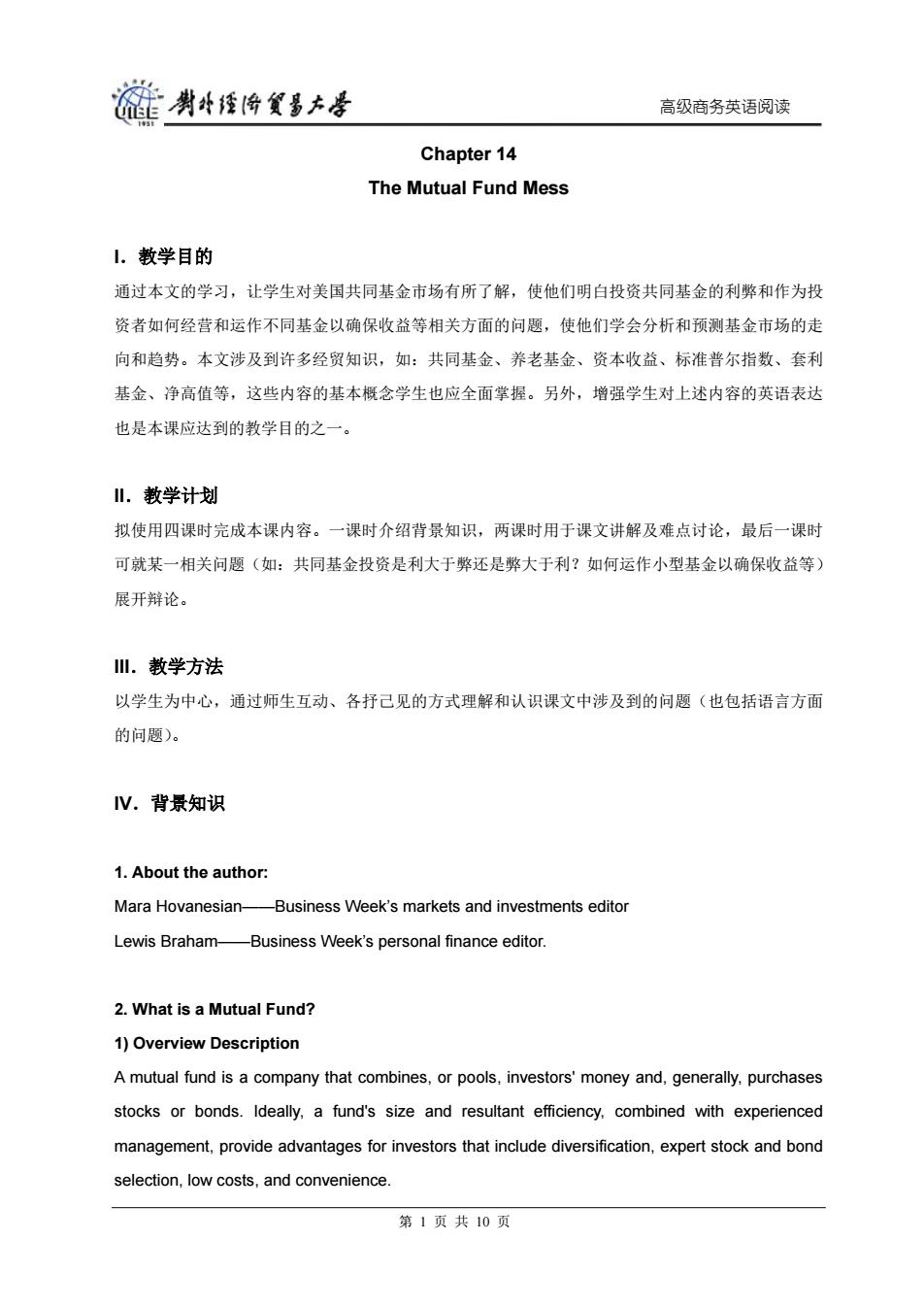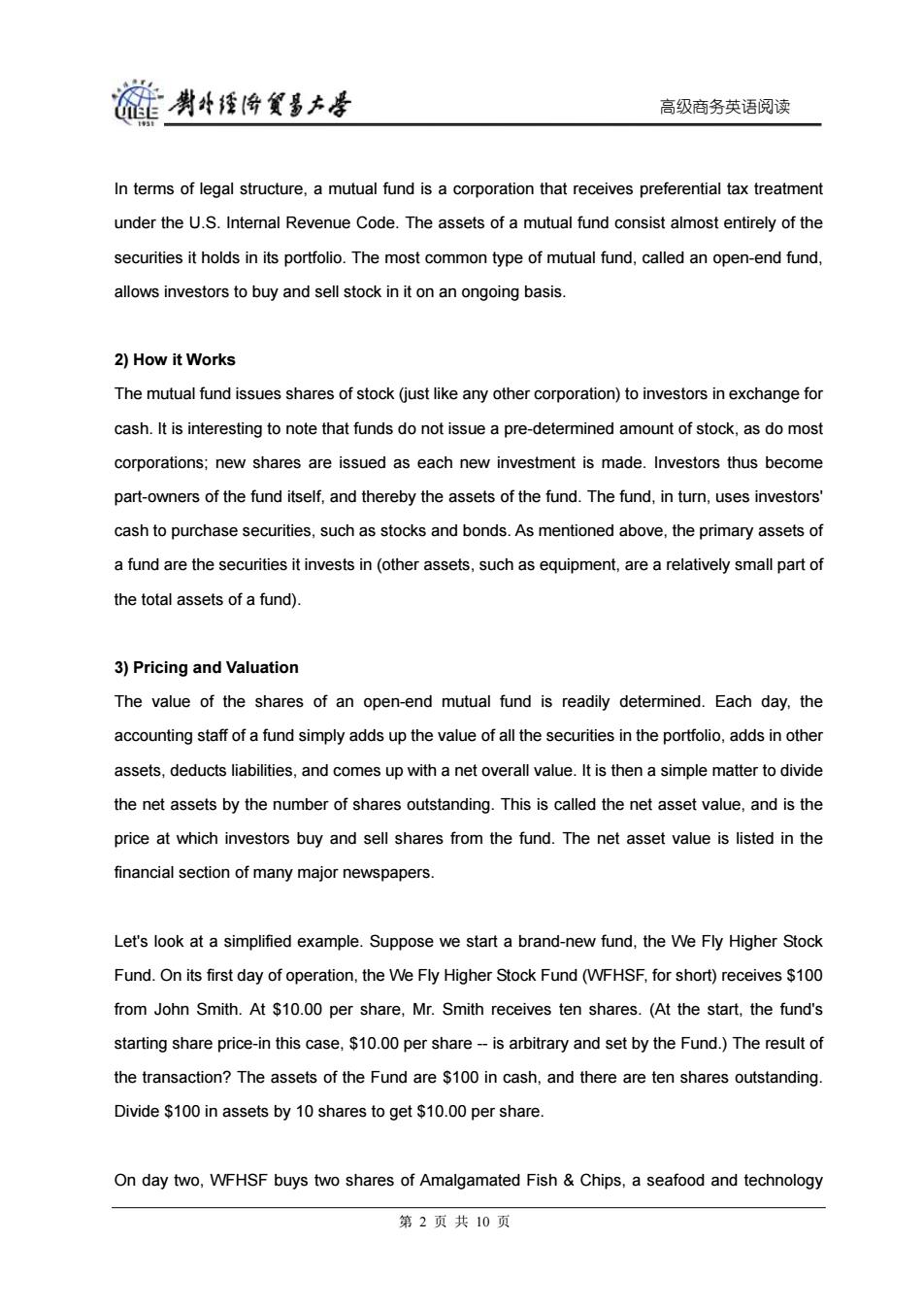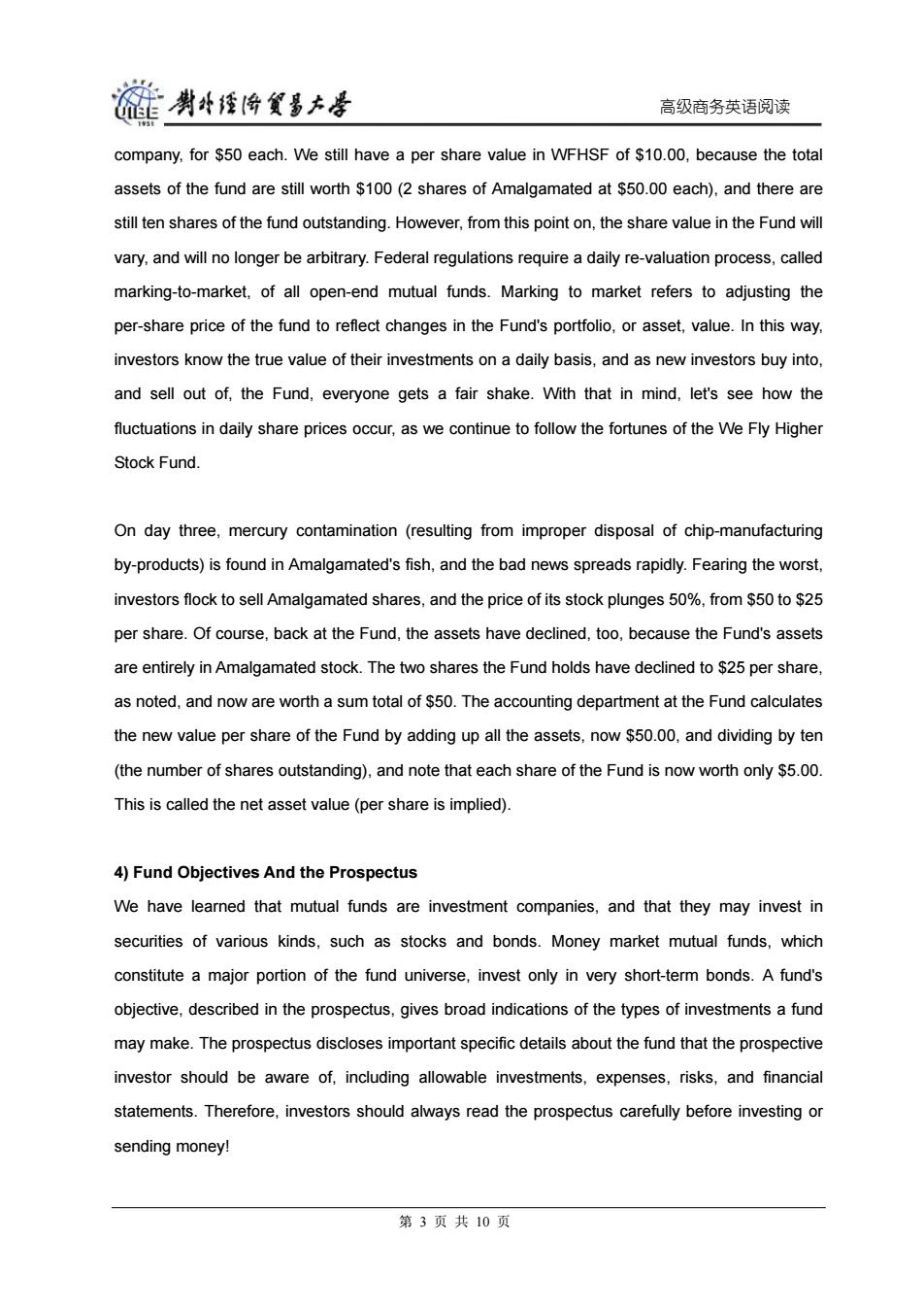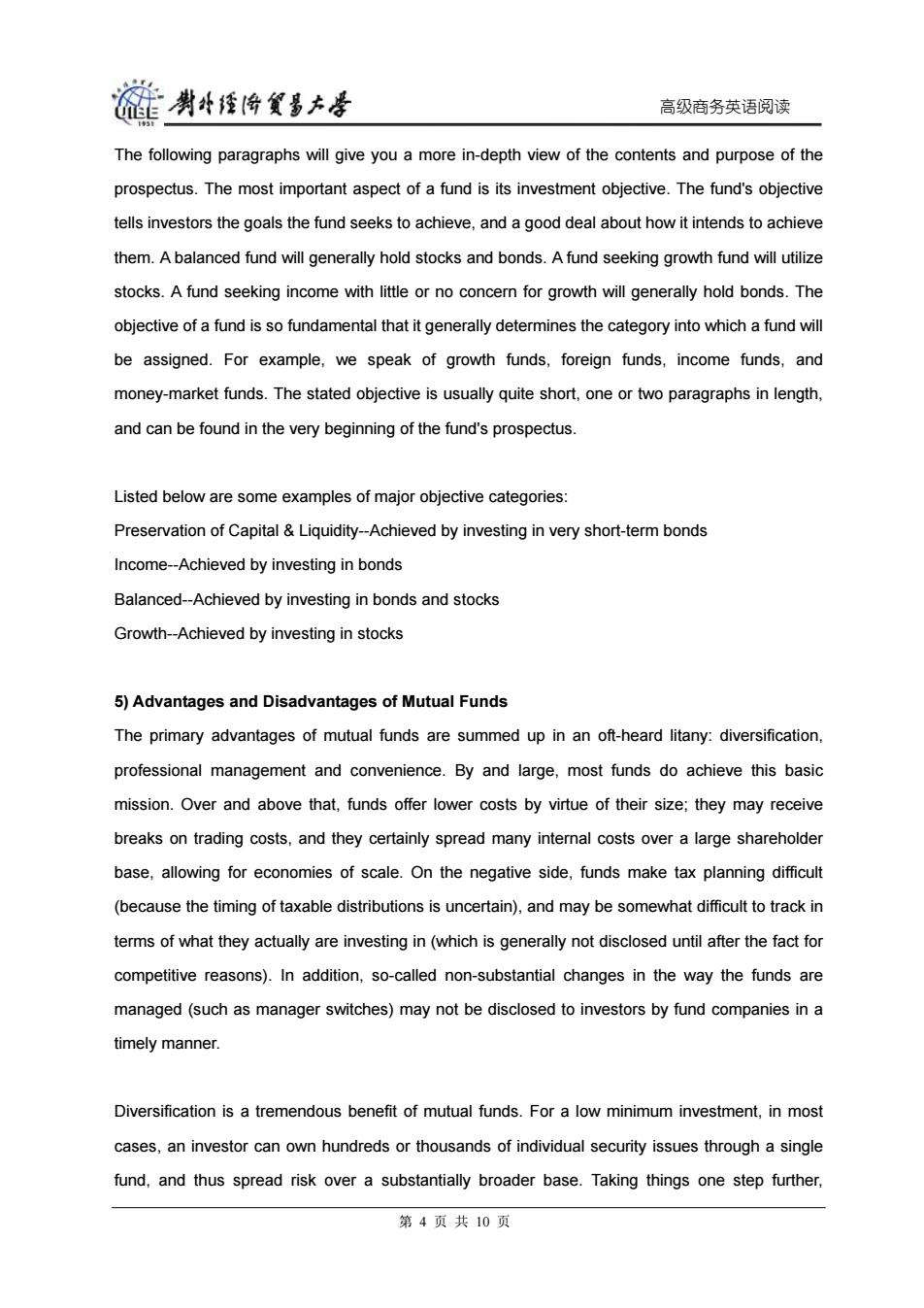
莲喇母矮降贸多大学 高级商务英语阅读 Chapter 14 The Mutual Fund Mess 1.教学目的 通过本文的学习,让学生对美国共同基金市场有所了解,使他们明白投资共同基金的利弊和作为投 资者如何经营和运作不同基金以确保收益等相关方面的问题,使他们学会分析和预测基金市场的走 向和趋势。本文涉及到许多经贸知识,如:共同基金、养老基金、资本收益、标准普尔指数、套利 基金、净高值等,这些内容的基本概念学生也应全面掌握。另外,增强学生对上述内容的英语表达 也是本课应达到的教学目的之一。 Ⅱ.教学计划 拟使用四课时完成本课内容。一课时介绍背景知识,两课时用于课文讲解及难点讨论,最后一课时 可就某一相关问题(如:共同基金投资是利大于弊还是弊大于利?如何运作小型基金以确保收益等) 展开辩论。 川.教学方法 以学生为中心,通过师生互动、各抒己见的方式理解和认识课文中涉及到的问题(也包括语言方面 的问题)。 IV.背景知识 1.About the author: Mara Hovanesian-Business Week's markets and investments editor Lewis Braham-Business Week's personal finance editor. 2.What is a Mutual Fund? 1)Overview Description A mutual fund is a company that combines,or pools,investors'money and,generally,purchases stocks or bonds.Ideally,a fund's size and resultant efficiency,combined with experienced management,provide advantages for investors that include diversification,expert stock and bond selection,low costs,and convenience 第1页共10页
高级商务英语阅读 Chapter 14 The Mutual Fund Mess I.教学目的 通过本文的学习,让学生对美国共同基金市场有所了解,使他们明白投资共同基金的利弊和作为投 资者如何经营和运作不同基金以确保收益等相关方面的问题,使他们学会分析和预测基金市场的走 向和趋势。本文涉及到许多经贸知识,如:共同基金、养老基金、资本收益、标准普尔指数、套利 基金、净高值等,这些内容的基本概念学生也应全面掌握。另外,增强学生对上述内容的英语表达 也是本课应达到的教学目的之一。 II.教学计划 拟使用四课时完成本课内容。一课时介绍背景知识,两课时用于课文讲解及难点讨论,最后一课时 可就某一相关问题(如:共同基金投资是利大于弊还是弊大于利?如何运作小型基金以确保收益等) 展开辩论。 III.教学方法 以学生为中心,通过师生互动、各抒己见的方式理解和认识课文中涉及到的问题(也包括语言方面 的问题)。 IV.背景知识 1. About the author: Mara Hovanesian——Business Week’s markets and investments editor Lewis Braham——Business Week’s personal finance editor. 2. What is a Mutual Fund? 1) Overview Description A mutual fund is a company that combines, or pools, investors' money and, generally, purchases stocks or bonds. Ideally, a fund's size and resultant efficiency, combined with experienced management, provide advantages for investors that include diversification, expert stock and bond selection, low costs, and convenience. 第 1 页 共 10 页

链男牛经海食多大学 高级商务英语阅读 In terms of legal structure,a mutual fund is a corporation that receives preferential tax treatment under the U.S.Internal Revenue Code.The assets of a mutual fund consist almost entirely of the securities it holds in its portfolio.The most common type of mutual fund,called an open-end fund, allows investors to buy and sell stock in it on an ongoing basis. 2)How it Works The mutual fund issues shares of stock(just like any other corporation)to investors in exchange for cash.It is interesting to note that funds do not issue a pre-determined amount of stock,as do most corporations;new shares are issued as each new investment is made.Investors thus become part-owners of the fund itself,and thereby the assets of the fund.The fund,in turn,uses investors' cash to purchase securities,such as stocks and bonds.As mentioned above,the primary assets of a fund are the securities it invests in(other assets,such as equipment,are a relatively small part of the total assets of a fund). 3)Pricing and Valuation The value of the shares of an open-end mutual fund is readily determined.Each day,the accounting staff of a fund simply adds up the value of all the securities in the portfolio,adds in other assets,deducts liabilities,and comes up with a net overall value.It is then a simple matter to divide the net assets by the number of shares outstanding.This is called the net asset value,and is the price at which investors buy and sell shares from the fund.The net asset value is listed in the financial section of many major newspapers. Let's look at a simplified example.Suppose we start a brand-new fund,the We Fly Higher Stock Fund.On its first day of operation,the We Fly Higher Stock Fund (WFHSF,for short)receives $100 from John Smith.At $10.00 per share,Mr.Smith receives ten shares.(At the start,the fund's starting share price-in this case,$10.00 per share--is arbitrary and set by the Fund.)The result of the transaction?The assets of the Fund are $100 in cash,and there are ten shares outstanding. Divide $100 in assets by 10 shares to get $10.00 per share. On day two,WFHSF buys two shares of Amalgamated Fish Chips,a seafood and technology 第2页共10页
高级商务英语阅读 In terms of legal structure, a mutual fund is a corporation that receives preferential tax treatment under the U.S. Internal Revenue Code. The assets of a mutual fund consist almost entirely of the securities it holds in its portfolio. The most common type of mutual fund, called an open-end fund, allows investors to buy and sell stock in it on an ongoing basis. 2) How it Works The mutual fund issues shares of stock (just like any other corporation) to investors in exchange for cash. It is interesting to note that funds do not issue a pre-determined amount of stock, as do most corporations; new shares are issued as each new investment is made. Investors thus become part-owners of the fund itself, and thereby the assets of the fund. The fund, in turn, uses investors' cash to purchase securities, such as stocks and bonds. As mentioned above, the primary assets of a fund are the securities it invests in (other assets, such as equipment, are a relatively small part of the total assets of a fund). 3) Pricing and Valuation The value of the shares of an open-end mutual fund is readily determined. Each day, the accounting staff of a fund simply adds up the value of all the securities in the portfolio, adds in other assets, deducts liabilities, and comes up with a net overall value. It is then a simple matter to divide the net assets by the number of shares outstanding. This is called the net asset value, and is the price at which investors buy and sell shares from the fund. The net asset value is listed in the financial section of many major newspapers. Let's look at a simplified example. Suppose we start a brand-new fund, the We Fly Higher Stock Fund. On its first day of operation, the We Fly Higher Stock Fund (WFHSF, for short) receives $100 from John Smith. At $10.00 per share, Mr. Smith receives ten shares. (At the start, the fund's starting share price-in this case, $10.00 per share -- is arbitrary and set by the Fund.) The result of the transaction? The assets of the Fund are $100 in cash, and there are ten shares outstanding. Divide $100 in assets by 10 shares to get $10.00 per share. On day two, WFHSF buys two shares of Amalgamated Fish & Chips, a seafood and technology 第 2 页 共 10 页

链剥挂将发多大是 高级商务英语阅读 company,for $50 each.We still have a per share value in WFHSF of $10.00,because the total assets of the fund are still worth $100(2 shares of Amalgamated at $50.00 each),and there are still ten shares of the fund outstanding.However,from this point on,the share value in the Fund will vary,and will no longer be arbitrary.Federal regulations require a daily re-valuation process,called marking-to-market,of all open-end mutual funds.Marking to market refers to adjusting the per-share price of the fund to reflect changes in the Fund's portfolio,or asset,value.In this way. investors know the true value of their investments on a daily basis,and as new investors buy into, and sell out of,the Fund,everyone gets a fair shake.With that in mind,let's see how the fluctuations in daily share prices occur,as we continue to follow the fortunes of the We Fly Higher Stock Fund. On day three,mercury contamination (resulting from improper disposal of chip-manufacturing by-products)is found in Amalgamated's fish,and the bad news spreads rapidly.Fearing the worst, investors flock to sell Amalgamated shares,and the price of its stock plunges 50%,from $50 to $25 per share.Of course,back at the Fund,the assets have declined,too,because the Fund's assets are entirely in Amalgamated stock.The two shares the Fund holds have declined to $25 per share, as noted,and now are worth a sum total of $50.The accounting department at the Fund calculates the new value per share of the Fund by adding up all the assets,now $50.00,and dividing by ten (the number of shares outstanding),and note that each share of the Fund is now worth only $5.00. This is called the net asset value(per share is implied). 4)Fund Objectives And the Prospectus We have learned that mutual funds are investment companies,and that they may invest in securities of various kinds,such as stocks and bonds.Money market mutual funds,which constitute a major portion of the fund universe,invest only in very short-term bonds.A fund's objective,described in the prospectus,gives broad indications of the types of investments a fund may make.The prospectus discloses important specific details about the fund that the prospective investor should be aware of,including allowable investments,expenses,risks,and financial statements.Therefore,investors should always read the prospectus carefully before investing or sending money! 第3页共10页
高级商务英语阅读 company, for $50 each. We still have a per share value in WFHSF of $10.00, because the total assets of the fund are still worth $100 (2 shares of Amalgamated at $50.00 each), and there are still ten shares of the fund outstanding. However, from this point on, the share value in the Fund will vary, and will no longer be arbitrary. Federal regulations require a daily re-valuation process, called marking-to-market, of all open-end mutual funds. Marking to market refers to adjusting the per-share price of the fund to reflect changes in the Fund's portfolio, or asset, value. In this way, investors know the true value of their investments on a daily basis, and as new investors buy into, and sell out of, the Fund, everyone gets a fair shake. With that in mind, let's see how the fluctuations in daily share prices occur, as we continue to follow the fortunes of the We Fly Higher Stock Fund. On day three, mercury contamination (resulting from improper disposal of chip-manufacturing by-products) is found in Amalgamated's fish, and the bad news spreads rapidly. Fearing the worst, investors flock to sell Amalgamated shares, and the price of its stock plunges 50%, from $50 to $25 per share. Of course, back at the Fund, the assets have declined, too, because the Fund's assets are entirely in Amalgamated stock. The two shares the Fund holds have declined to $25 per share, as noted, and now are worth a sum total of $50. The accounting department at the Fund calculates the new value per share of the Fund by adding up all the assets, now $50.00, and dividing by ten (the number of shares outstanding), and note that each share of the Fund is now worth only $5.00. This is called the net asset value (per share is implied). 4) Fund Objectives And the Prospectus We have learned that mutual funds are investment companies, and that they may invest in securities of various kinds, such as stocks and bonds. Money market mutual funds, which constitute a major portion of the fund universe, invest only in very short-term bonds. A fund's objective, described in the prospectus, gives broad indications of the types of investments a fund may make. The prospectus discloses important specific details about the fund that the prospective investor should be aware of, including allowable investments, expenses, risks, and financial statements. Therefore, investors should always read the prospectus carefully before investing or sending money! 第 3 页 共 10 页

链男4经降贸多大是 高级商务英语阅读 The following paragraphs will give you a more in-depth view of the contents and purpose of the prospectus.The most important aspect of a fund is its investment objective.The fund's objective tells investors the goals the fund seeks to achieve,and a good deal about how it intends to achieve them.A balanced fund will generally hold stocks and bonds.A fund seeking growth fund will utilize stocks.A fund seeking income with little or no concern for growth will generally hold bonds.The objective of a fund is so fundamental that it generally determines the category into which a fund will be assigned.For example,we speak of growth funds,foreign funds,income funds,and money-market funds.The stated objective is usually quite short,one or two paragraphs in length, and can be found in the very beginning of the fund's prospectus. Listed below are some examples of major objective categories: Preservation of Capital Liquidity--Achieved by investing in very short-term bonds Income--Achieved by investing in bonds Balanced--Achieved by investing in bonds and stocks Growth--Achieved by investing in stocks 5)Advantages and Disadvantages of Mutual Funds The primary advantages of mutual funds are summed up in an oft-heard litany:diversification, professional management and convenience.By and large,most funds do achieve this basic mission.Over and above that,funds offer lower costs by virtue of their size;they may receive breaks on trading costs,and they certainly spread many internal costs over a large shareholder base,allowing for economies of scale.On the negative side,funds make tax planning difficult (because the timing of taxable distributions is uncertain),and may be somewhat difficult to track in terms of what they actually are investing in(which is generally not disclosed until after the fact for competitive reasons).In addition,so-called non-substantial changes in the way the funds are managed(such as manager switches)may not be disclosed to investors by fund companies in a timely manner. Diversification is a tremendous benefit of mutual funds.For a low minimum investment,in most cases,an investor can own hundreds or thousands of individual security issues through a single fund,and thus spread risk over a substantially broader base.Taking things one step further, 第4页共10页
高级商务英语阅读 The following paragraphs will give you a more in-depth view of the contents and purpose of the prospectus. The most important aspect of a fund is its investment objective. The fund's objective tells investors the goals the fund seeks to achieve, and a good deal about how it intends to achieve them. A balanced fund will generally hold stocks and bonds. A fund seeking growth fund will utilize stocks. A fund seeking income with little or no concern for growth will generally hold bonds. The objective of a fund is so fundamental that it generally determines the category into which a fund will be assigned. For example, we speak of growth funds, foreign funds, income funds, and money-market funds. The stated objective is usually quite short, one or two paragraphs in length, and can be found in the very beginning of the fund's prospectus. Listed below are some examples of major objective categories: Preservation of Capital & Liquidity--Achieved by investing in very short-term bonds Income--Achieved by investing in bonds Balanced--Achieved by investing in bonds and stocks Growth--Achieved by investing in stocks 5) Advantages and Disadvantages of Mutual Funds The primary advantages of mutual funds are summed up in an oft-heard litany: diversification, professional management and convenience. By and large, most funds do achieve this basic mission. Over and above that, funds offer lower costs by virtue of their size; they may receive breaks on trading costs, and they certainly spread many internal costs over a large shareholder base, allowing for economies of scale. On the negative side, funds make tax planning difficult (because the timing of taxable distributions is uncertain), and may be somewhat difficult to track in terms of what they actually are investing in (which is generally not disclosed until after the fact for competitive reasons). In addition, so-called non-substantial changes in the way the funds are managed (such as manager switches) may not be disclosed to investors by fund companies in a timely manner. Diversification is a tremendous benefit of mutual funds. For a low minimum investment, in most cases, an investor can own hundreds or thousands of individual security issues through a single fund, and thus spread risk over a substantially broader base. Taking things one step further, 第 4 页 共 10 页

链喇哈餐多方孝 高级商务英语阅读 different types of funds allow participation in many types of securities,such as foreign stocks, foreign bonds,real estate securities,technology stocks,small companies,and so on.Thus,a single investor can assemble a portfolio of mutual funds that invest in different asset classes.The chance of any single person being sufficiently well-versed to manage such diverse investments is highly unlikely,even if done full-time!In the extreme,funds may even own other mutual funds, resulting in a virtual all-in-one portfolio.An example of the all-in-one,"fund of funds"approach would be Vanguard's Star Fund.The Star Fund invests in about eight other Vanguard funds with different objectives--small stock,blue chip stock,bonds,etc.-with no additional expenses added onto the low expenses of the underlying funds.Such a fund might serve as an entire investment portfolio for the small investor. The second potential benefit,professional management,is always guaranteed,but sadly,only because managers of funds are paid for their services.Fortunately,truly dismal mutual fund management is rare(I can think of only a handful of cases where investment returns have badly trailed the relevant market measures over substantial periods of time).Finally,there is no doubt that investors benefit from substantial convenience by investing in mutual funds.They are relieved of the day-to-day tasks involved in researching,buying and selling securities.In the case of individual securities,day-to-day vigilance is a virtual requirement,especially in a diversified portfolio,with many holdings.Mutual funds,on the other hand,need not be looked at on a daily, weekly or even monthly basis.Occasional reviews,perhaps once a year,will suffice.(Helpful Hint: the same guidelines and practices for picking a mutual fund in the first place are also useful for fund reviews.) Perhaps the biggest negative aspect of mutual funds is tax-planning difficulty and uncertainty. Funds make taxable distributions in a largely hard-to-foresee manner.In addition,they are required to distribute long-term capital gains in the year realized;thus the investor loses control over the timing of the realization and taxation of capital gains,contrary to the situation where an investor who owns securities outright,can choose sale dates. 2.Small Fund Comes into Being This is the year of the boutique manager.The industry's stars look a lot like Boston Partners Asset 第5页共10页
高级商务英语阅读 different types of funds allow participation in many types of securities, such as foreign stocks, foreign bonds, real estate securities, technology stocks, small companies, and so on. Thus, a single investor can assemble a portfolio of mutual funds that invest in different asset classes. The chance of any single person being sufficiently well-versed to manage such diverse investments is highly unlikely, even if done full-time! In the extreme, funds may even own other mutual funds, resulting in a virtual all-in-one portfolio. An example of the all-in-one, "fund of funds" approach would be Vanguard's Star Fund. The Star Fund invests in about eight other Vanguard funds with different objectives -- small stock, blue chip stock, bonds, etc. -- with no additional expenses added onto the low expenses of the underlying funds. Such a fund might serve as an entire investment portfolio for the small investor. The second potential benefit, professional management, is always guaranteed, but sadly, only because managers of funds are paid for their services. Fortunately, truly dismal mutual fund management is rare (I can think of only a handful of cases where investment returns have badly trailed the relevant market measures over substantial periods of time). Finally, there is no doubt that investors benefit from substantial convenience by investing in mutual funds. They are relieved of the day-to-day tasks involved in researching, buying and selling securities. In the case of individual securities, day-to-day vigilance is a virtual requirement, especially in a diversified portfolio, with many holdings. Mutual funds, on the other hand, need not be looked at on a daily, weekly or even monthly basis. Occasional reviews, perhaps once a year, will suffice. (Helpful Hint: the same guidelines and practices for picking a mutual fund in the first place are also useful for fund reviews.) Perhaps the biggest negative aspect of mutual funds is tax-planning difficulty and uncertainty. Funds make taxable distributions in a largely hard-to-foresee manner. In addition, they are required to distribute long-term capital gains in the year realized; thus the investor loses control over the timing of the realization and taxation of capital gains, contrary to the situation where an investor who owns securities outright, can choose sale dates. 2. Small Fund Comes into Being This is the year of the boutique manager. The industry's stars look a lot like Boston Partners Asset 第 5 页 共 10 页